

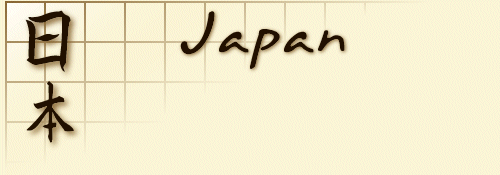
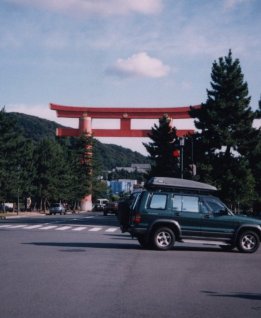
Heian shrine is named after the Heian era in Japan. I'm not sure what years encompassed the Heian era, but it was at least 300-400 years ago. The shrine itself was built in the Meiji era (1867-1911) to comemorate the Heian era, and is supposed to have been constructed in the style of buildings from that era. This was our last major tourist stop in Kyoto, as Daria and I had to catch a plane out of Kansai Airport the next day.
This first photo is the tori to the Heian shrine. It spans a large road, as you can no doubt see in the photo. This is by far the largest tori I've ever seen. Tori are gates into Shinto shrines, and are a very common sight throughout Japan. There are bright gold accents on it, as well. I'm not sure if they are real gold, but I wouldn't be surprised to find out they are after seeing Kinkakuji. The tori is painted a bright reddish-orange, which is one of the colors used on the rest of the Heian shrine as well. This color is often used for Shinto shrines, and it's called "shuiro" in Japanese, which means "shrine color".
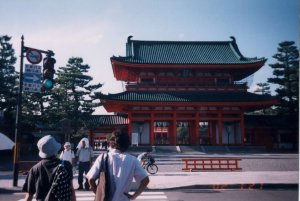
This next photo is the actual entrance onto the grounds of the shrine. Here you can again see the bright reddish-orange of shuiro, and the shrine's other two colors are also in evidence, a deep pine green on the roofs, and white. The entire shrine is decorated these colors.
As a funny little side note, you can see a man wearing a towel over his head in this photo. This is not an uncommon sight in Japan. I didn't realize this before I came to Japan, but a large portion of Japan is very warm in the summer. Japanese weather is a little extreme. It's very hot in the summer throughout most of Japan, and quite cold in the winter as well, though not as cold as my native Michigan. Kyoto is especially hot. I've been told that's because it rests in a valley, and all the heat produced in the city just kind of hovers there. Kyoto is most popular as a tourist attraction in mid-spring, around April, because it's not so hot yet, and the sakura (cherry blossoms) are blooming. Visiting in the height of the summer was very hot, but it wasn't nearly as crowded.
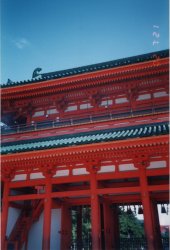
I'm sure this is mentioned other places in my site, but I simply adore traditional Japanese architecture. I especially love Japanese roofs. It would probably be prohibitively expensive to construct such a roof in the States, but I would love to try someday. This photo is a closeup of the entrance into the Heian shrine, and it provides a decent view of the style I enjoy so much.
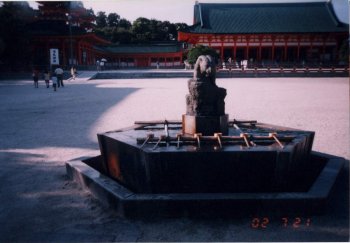
On the right is a photo of a fountain. These are near most shrines in Japan. There were two in the Heian shrine, one at each end of the large courtyard. These are used to wash your hands before you pray. The ladles are made with bamboo. Every one of these fountains has had the exact same kind of ladle, which are remarkably similar, though larger in size, to the ones used in the Japanese tea ceremony. I did see a Japanese person use one to get a drink before, but I've been informed that that's the worst of bad manners, so I've never tried it myself, though in some of the remoter regions, where there are no vending machines or restaurants, it can be really tempting after a long walk or climb up a mountain!
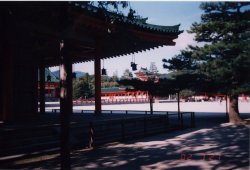
This is a photo of the courtyards. This is one of the largest open spaces I have ever seen in Japan! In the States we like large open ground to be either paved, or covered with grass, but in Japan they tend to be simply hard packed dirt or relatively fine gravel. Most schools have sports fields that are simply hard-packed dirt. Sports can be interesting on such fields when it rains!
The Heian shrine isn't simply a place to sell lucky charms with a large courtyard, however! There is also a very large and beautiful garden. Entrance into the shrine is free, but there is a fee for entering the garden. In the spring, the garden is filled with cherry blossoms, and is famous as one of the most beautiful gardens in Japan. We were three months too late for cherry blossom season, but the gardens were still magnificent! There was only one problem with getting in...the guard didn't want to allow three gaijin to view the gardens!
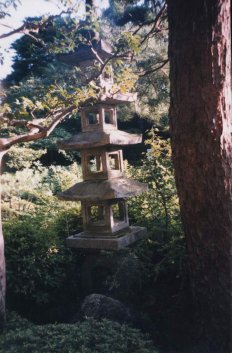
Getting the guard to allow us to even buy a ticket was difficult! This was by far the worst experience with Japanese racism I've ever had! Jayne had been here before, and she'd greatly enjoyed the gardens, so, even though it was relatively late in the day, we decided to do a quick run through the gardens before they closed. It was about 5:15pm, and the entrance to the gardens closed at 5:30, though the gardens themselves were open until 6, so we quickly followed the signs that led to the entrance so we could get in. The guard there informed us that where we were was no longer the entrance. He pointed back in the direction we came from and asked us to enter there. We (especially Jayne, with her excellent Japanese) protested a bit that we'd followed the signs here, but he insisted, so we quickly went in the direction he pointed...to find the bathrooms! Disgusted, we asked a nearby miko (shrine maiden) about where we should go to see the gardens. She pointed back to the guard! We explained that he had directed us over here, but she shook her head and said she didn't know what the guard was talking about, the garden entrance was where the signs indicated it was. We were running short on time, so we jogged back toward the guard. As we neared him he quickly turned and began to lock the entrance gate to the gardens, five minutes early! Jayne angrily explained what we had been told by the miko, and asked where we pay to get in. The guard walked over to a little booth in a recessed corner and asked another miko, who was selling tickets for the garden, if she was closed. The miko gave him a strange look and said she was still open.
"No, no, you're closed, aren't you?" the guard asked (in Japanese, of course!). The miko again protested she was still opened so we quickly shoved past the guard and bought tickets to enter the gardens. He let us in, finally! Then, to add final insult to injury, for the next half hour he followed about five steps behind us through our tour of the garden!

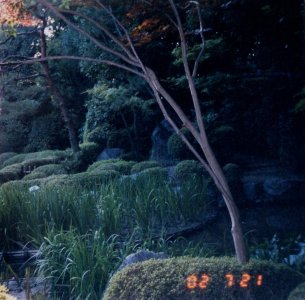
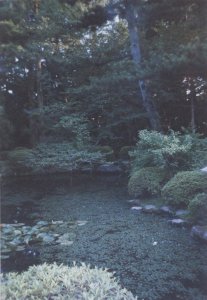
As I mentioned before, Jayne had been to the Heian shrine and gardens before. She claimed the only really interesting thing to see were the fish that lived in the pond. Daria and I began to call them her pets, and they did seem to like her! Every time she came to the water's edge they crowded around her and poked their mouths out of the water, as they're doing here! We also found the sign highly amusing. It says, in case you can't read the small Enlish words, "Please don't touch life in the pond." I'm not really sure any more why we found this hilarious, but at the time, we would break up in uncontrolled laughter every time it was mentioned. Maybe we were just venting our frustration with the guard, who was watching us carefully the entire time we were there.
I found the gardens beautiful. Photos can't really do them justice, but it was wonderful while I was there. I'm sure it would be even more beautiful in the spring or fall, when more color would be evident, but even just the rich greens of the garden in summer were enjoyable. I can see how they would be a welcome and relaxing retreat from the busy life of urban Kyoto!